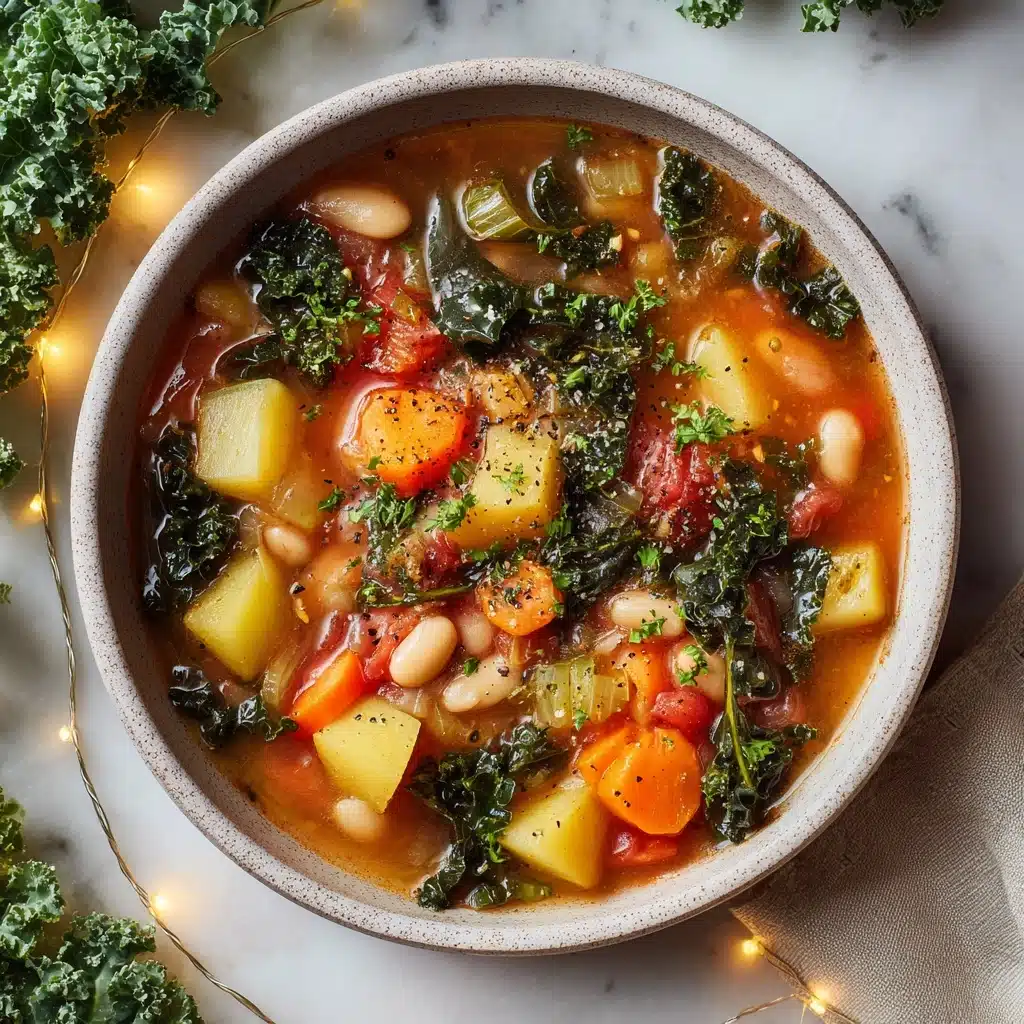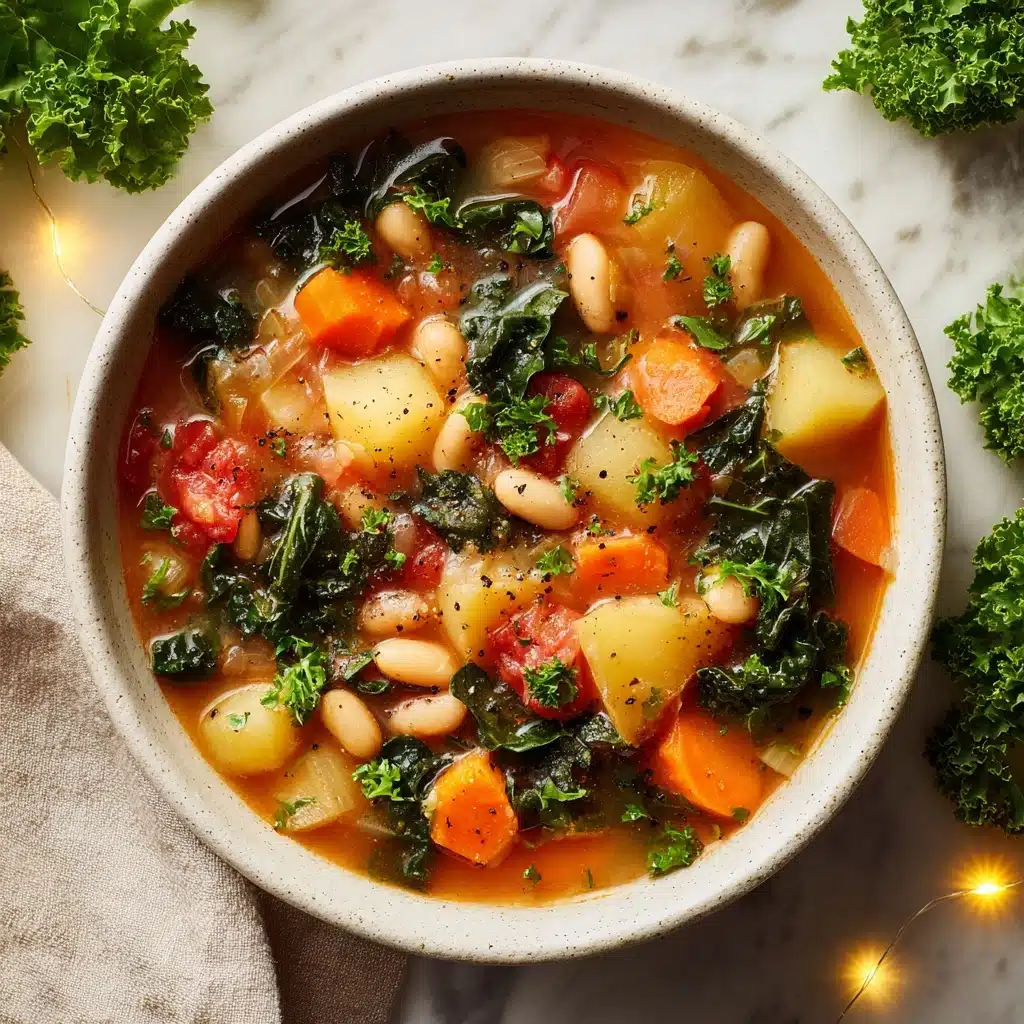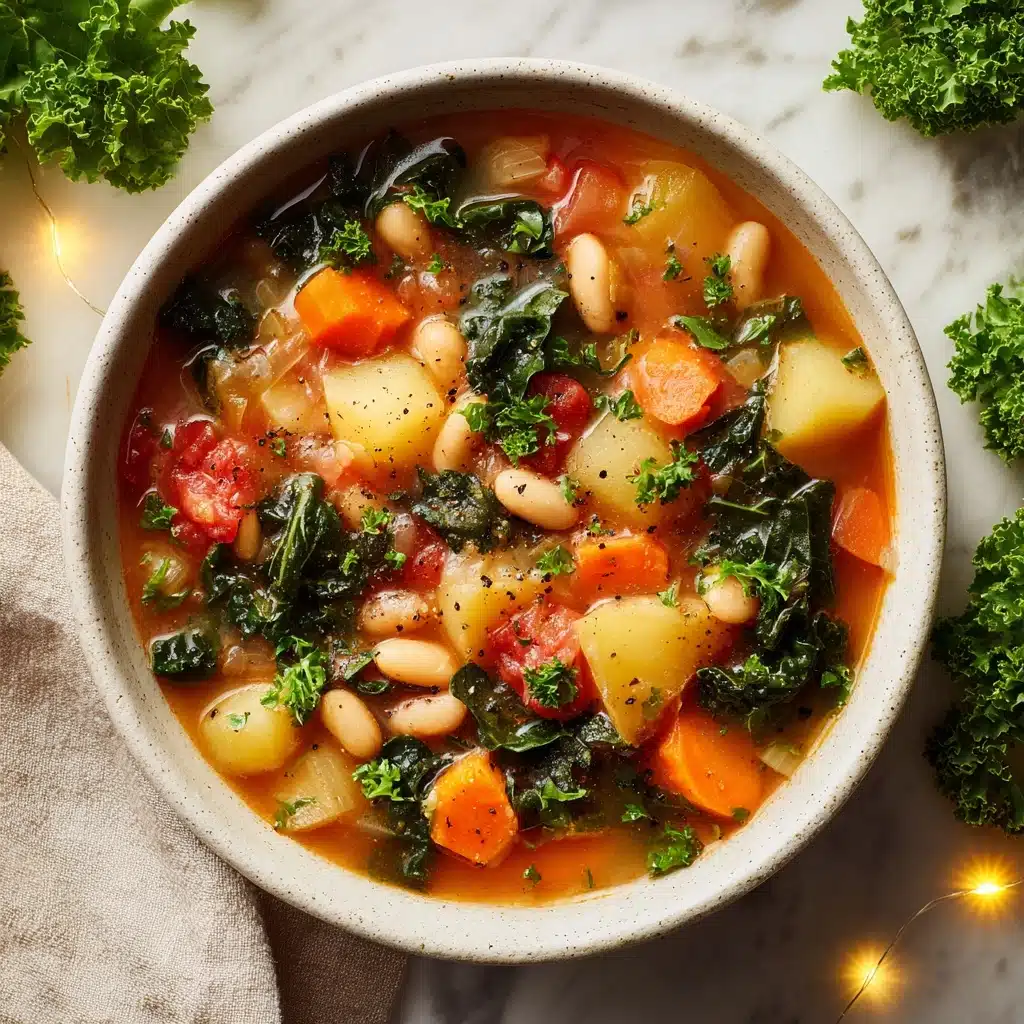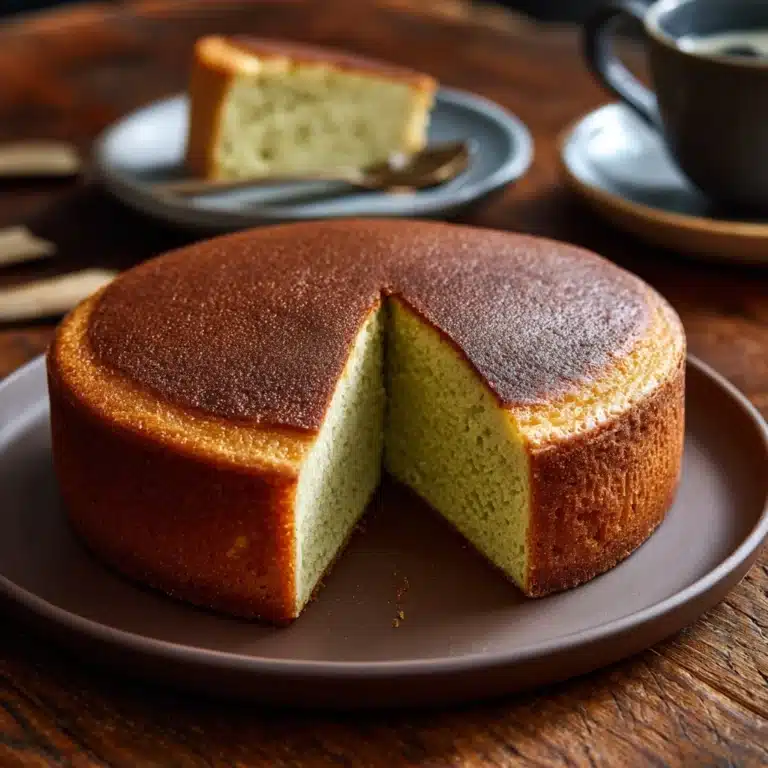If you’re looking for the kind of meal that instantly warms your soul and fills your kitchen with cozy aromas, Winter Minestrone Soup is that magical bowl of comfort. This hearty Italian classic brings together vibrant winter vegetables, creamy beans, savory herbs, and just enough pasta to make every spoonful satisfying. Whether you’re seeking a wholesome family dinner or a nourishing make-ahead lunch, Winter Minestrone Soup is always there like a hug from your favorite sweater—full of goodness, color, and just the right touch of rustic charm.

Ingredients You’ll Need
Every ingredient in this Winter Minestrone Soup pulls its weight—offering rich flavor, beautiful color, or that extra dose of texture. The list may look abundant, but each item plays an unmistakable part, making the final soup truly special.
- Olive oil: The base of every great Italian soup, it adds fruitiness and helps soften the vegetables beautifully.
- Yellow onion: Offers sweet depth and aroma that builds the soup’s foundation.
- Garlic: Packs a punch of earthy, pungent flavor that’s classic in minestrone.
- Carrots: Bring gentle sweetness and gorgeous color to the mix.
- Celery: Provides a subtle savory crunch and essential aromatic kick.
- Zucchini: Softens into the broth, adding delicate texture and a hint of summer freshness.
- Butternut squash: Its hearty creaminess balances the other veggies and gives that signature winter hug.
- Canned diced tomatoes: Add brightness, acidity, and a lovely red hue to the soup.
- Cannellini beans: Creamy and hearty, these beans add protein and a velvety bite.
- Vegetable broth: The savory liquid gold that marries all the ingredients together.
- Kale or Swiss chard: Leafy and robust, these greens add color and a slightly bitter contrast.
- Small pasta (ditalini): Tiny pasta shapes give each spoonful the perfect bite and tender chew.
- Dried thyme: Earthy and aromatic, it infuses depth and a faint woodsy note.
- Dried oregano: Brings classic Italian vibes and an herby warmth.
- Bay leaf: Adds a background layer of subtle flavor—just remember to pull it out before serving!
- Salt and black pepper: Essential for heightening every other flavor in this soup.
- Grated Parmesan cheese: Salty, nutty, and absolutely delicious on top of your finished bowl.
- Fresh parsley: An emerald sprinkle that brightens up every serving just before it hits the table.
How to Make Winter Minestrone Soup
Step 1: Build the Flavor Base
Start by heating the olive oil in a big, sturdy soup pot over medium heat. Toss in your diced onion and let it soften until translucent and fragrant, about 3 to 4 minutes. This is where the magic begins, creating the aromatic heart for your Winter Minestrone Soup. Next, add the garlic, carrots, and celery, stirring everything together for another 5 minutes until the veggies start to soften and release their sweet, savory scents.
Step 2: Bulk Up with Vegetables
Add your chopped zucchini and butternut squash directly to the pot. Stir gently, and let them cook for 2 to 3 minutes. This brief sauté brings out their flavors and helps them hold their shape in the final soup. It’s this mix of winter and late-harvest veggies that gives Winter Minestrone Soup its irresistible texture and color.
Step 3: Pour in Tomatoes, Beans, and Broth
Crack open your can of diced tomatoes (don’t drain them!) and pour the contents into the pot along with the cannellini beans and vegetable broth. Stir well to combine. You’re already halfway to dinner as those flavors start to meld, creating the rich backbone of your soup.
Step 4: Season and Simmer
Now sprinkle in the dried thyme, oregano, bay leaf, salt, and black pepper. Give everything a good stir, then bring the soup up to a gentle boil. As soon as it bubbles, turn the heat down and let it simmer for 15 minutes. This step makes sure every ingredient gets the love it deserves, and your house might just start to smell irresistible.
Step 5: Add Pasta and Greens
After that first simmer, toss in your small pasta—ditalini is perfect—and the chopped kale or Swiss chard. Simmer the soup for another 10 to 12 minutes, until the pasta and vegetables are tender but still slightly firm. At this point, the soup is thick, luscious, and vibrant, with each ingredient holding its own in every spoonful of Winter Minestrone Soup.
Step 6: Taste and Finish
Fish out the bay leaf, then grab a spoon and taste your soup. Adjust the salt and pepper, if needed. Ladle the steaming Winter Minestrone Soup into bowls, top each with a generous sprinkle of grated Parmesan and a dash of fresh parsley. You did it—soup perfection!
How to Serve Winter Minestrone Soup

Garnishes
Don’t skimp on the toppings; a shower of grated Parmesan cheese adds a nutty saltiness that melts right in, while a scatter of fresh parsley brings bright color and freshness. For a spicy kick, a pinch of red pepper flakes is always welcome. Crusty bread for dunking is non-negotiable if you ask me!
Side Dishes
Winter Minestrone Soup pairs beautifully with a rustic, toasted sourdough, garlic bread, or a bracingly fresh green salad. If you’re in the mood for something extra, serve alongside a small antipasto platter of olives, artichokes, and sharp cheeses. It’s an Italian-inspired feast that feels both casual and special.
Creative Ways to Present
For a cozy dinner party, try serving Winter Minestrone Soup in hollowed-out bread bowls or adorable mini Dutch ovens. Or, set up a “soup bar” with little ramekins of your favorite toppings—fresh herbs, more cheese, chopped nuts, or even a drizzle of good olive oil. It’s fun, interactive, and makes everyone feel right at home.
Make Ahead and Storage
Storing Leftovers
Winter Minestrone Soup tastes even better the next day, once the flavors have had a chance to deepen. Transfer leftovers to an airtight container and stash them in the refrigerator, where they’ll be delicious for up to 4 days. You might notice the pasta soaks up more broth as it sits, which just intensifies that cozy, rib-sticking quality.
Freezing
If you’re planning ahead, simply let the soup cool completely, then ladle it into freezer-safe containers or bags—leaving a little space for expansion. Freeze for up to 3 months. If you know you’ll be freezing the whole batch, you can even cook the pasta separately and add it fresh when reheating, to avoid mushiness.
Reheating
To warm up your Winter Minestrone Soup, just reheat on the stove over medium-low heat, stirring occasionally until piping hot. You may want to add a splash of broth or water if things get too thick. For quick lunches, microwave individual portions—just don’t forget to stop and stir halfway through.
FAQs
Can I make Winter Minestrone Soup vegan?
Absolutely! Just skip the Parmesan or swap it out for your favorite plant-based cheese, and you’ll have a wonderfully hearty vegan meal that’s still bursting with flavor.
What other vegetables can I add?
This soup is wonderfully flexible—try adding potatoes, green beans, peas, or even shredded cabbage. Think of whatever looks fresh and inspiring at the market, or what needs using up in your fridge.
Is it okay to use another type Soup
Definitely. Cannellini beans are traditional, but kidney beans, great northern beans, or even chickpeas work just as well and provide their own twist on the classic Winter Minestrone Soup experience.
Can I use gluten-free pasta?
Yes! Gluten-free small pasta shapes cook up beautifully in the soup—just keep an eye on the cooking time, as some types soften faster, and be aware they may firm up a little more when chilled or frozen.
How do I avoid mushy vegetables?
The key is not to overcook—add your veggies in stages as described, and aim for a gentle simmer rather than a rolling boil. This keeps your greens vibrant, your pasta just right, and the entire potful tasting garden-fresh.
Final Thoughts
There’s nothing quite like a steaming bowl of Winter Minestrone Soup on a chilly day—the kind of meal that gathers everyone around the table, smiles included. Whether it’s your first time making it or a well-loved tradition, I hope you give this recipe a go and savor every last spoonful. Enjoy, and stay warm!
Print
Winter Minestrone Soup Recipe
- Total Time: 50 minutes
- Yield: 6 servings 1x
- Diet: Vegetarian
Description
A comforting and hearty Winter Minestrone Soup recipe that is packed with vegetables, beans, and pasta in a flavorful broth, topped with Parmesan and fresh parsley.
Ingredients
Broth:
- 2 tablespoons olive oil
- 1 medium yellow onion, diced
- 2 cloves garlic, minced
- 4 cups vegetable broth
Veggies and Beans:
- 2 medium carrots, diced
- 2 celery stalks, diced
- 1 medium zucchini, diced
- 2 cups chopped butternut squash
- 1 can (14 ounces) diced tomatoes
- 1 can (15 ounces) cannellini beans, drained and rinsed
- 2 cups chopped kale or Swiss chard
Seasonings and Others:
- 1/2 cup small pasta (like ditalini)
- 1 teaspoon dried thyme
- 1 teaspoon dried oregano
- 1 bay leaf
- Salt and black pepper to taste
- 1/4 cup grated Parmesan cheese for serving
- Fresh parsley for garnish
Instructions
- Sauté Aromatics: In a large pot, heat olive oil, sauté onion until soft, then add garlic, carrots, and celery.
- Add Veggies: Stir in zucchini, squash, tomatoes, beans, broth, thyme, oregano, bay leaf, salt, and pepper.
- Simmer: Bring to a boil, then simmer for 15 minutes.
- Add Pasta and Greens: Add pasta and kale, cook for 10-12 minutes until tender.
- Finish: Remove bay leaf, adjust seasoning, then serve topped with Parmesan and parsley.
Notes
- For a heartier soup, add cooked Italian sausage or pancetta.
- Make it vegan by skipping the Parmesan or using a dairy-free alternative.
- Prep Time: 15 minutes
- Cook Time: 35 minutes
- Category: Soup
- Method: Stovetop
- Cuisine: Italian
Nutrition
- Serving Size: 1 bowl
- Calories: 220
- Sugar: 7g
- Sodium: 420mg
- Fat: 7g
- Saturated Fat: 2g
- Unsaturated Fat: 4g
- Trans Fat: 0g
- Carbohydrates: 31g
- Fiber: 7g
- Protein: 9g
- Cholesterol: 5mg







